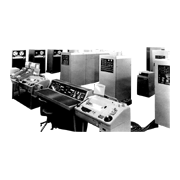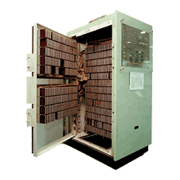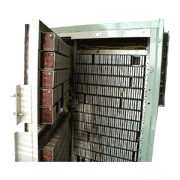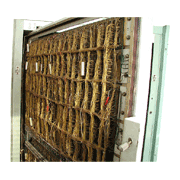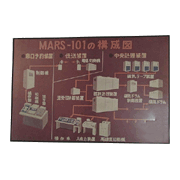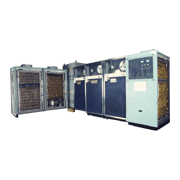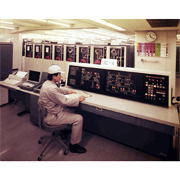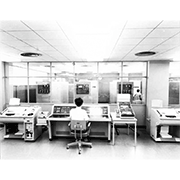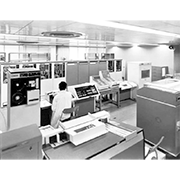MARS 101
MARS 101 was a seat reservation system developed by the Japanese National Railways (JNR; today, Japan Railways) that followed in the footsteps of the MARS 1. Where MARS 1 was a prototype machine, MARS 101 was Japan’s first true online real-time information processing system. The MARS 101 development aimed to computerize not just seat reservations but also the entire reservation business process for dozens of trains nationwide. The system was jointly developed by JNR and Hitachi following an original plan created by Mamoru Hosaka, who had moved from JNR to the University of Tokyo. The system’s central processing equipment was installed in Tokyo’s Akihabara Station in 1963, and it took over operations from MARS 1 in February of 1964. The system initially managed reservations for 2,400 seats on four trains, but this was expanded to handle 32,000 seats on 72 trains by March. In October, with the addition of the similarly configured MARS 102, “Midori-no-madoguchi” ticket reservation counters were installed in 152 train stations across the country. By the end of the year, the system had automated reservations up to eight days in advance for 127,000 seats on 238 trains.
The system consisted of a computer for searching trains, schedules, fares, and other tables, a computer for looking up and updating vacant seat patterns using seating files, and a main computer that managed and controlled the system’s overall processing sequence. These computers exchanged data using a shared magnetic core memory unit. Tables, seating files, and other fixed data were stored on magnetic drums. For high reliability and availability, the system featured full redundancy. Original real-time control programs had to be developed because at the time the concepts of operating systems and multi-programs did not exist.
Ingenious solutions were needed for the ticket counter devices because at the time reservation agents who were responsible for issuing tickets were not trained in keyboard typing skills and there were no Japanese-language printers for printing reserved-seat tickets or passenger tickets. What was used were flat wooden blocks with the names of stations and trains on the end and codes that could be read mechanically on the sides. By inserting the proper wooden blocks in the input device, reservation agents were able to input reservation data and print tickets.
The HITAC 3030 was developed to be the system’s central processing machine. This machine was later used for online systems at ANA, Tokai Bank, and other businesses.
A number of machines were developed after the MARS 101. The sections below give brief summaries of each.
MARS 102
MARS 102 was added in October 1965 as additional trains were put on the Tokaido Shinkansen (bullet train) line, and it began operation at the same time the “Midori-no-madoguchi” ticket reservation counters opened. MARS 101 could not handle reservations for bullet trains because it could only allocate tickets for trains with four people or less per row. MARS 102, on the other hand, had a new seat-file controller so that it could handle the seating arrangements on bullet trains. It was also designed to handle connecting reservations between regular (non-bullet) trains and between regular trains and bullet trains. The combined MARS 101 and MARS 102 system was capable of managing reservations for about 150,000 seats, about five times more than the previous system.
MARS 103
MARS 103 was added in keeping with the complete timetable overhaul in October 1968. MARS 103 made it possible to process reservations for 200,000 seats a day up to one week in advance (up to three weeks in advance for some seats).
Unlike MARS 1, 101, and 102, the MARS 103 system used a mainframe computer. The MARS 103 central processing unit consisted of an online system that ran two HITAC 8400 large general-purpose computers in parallel and an offline system with one HITAC 8400 for statistical processes done in conjunction with reservation processes. A dedicated operating system was also developed for the MARS 103 with functions to improve the system’s reliability. Functions included retries when discrepancies occurred between the two computers while operating in parallel; auto reconfiguration control between operating modes — either standalone double-redundancy file operation, which connected pairs of files on single processing units, or standalone single-redundancy file operation; auto control over partial isolation when certain files or components fail; and safeguards against system interruption by momentary failures. Software that ran routine daily tasks in conjunction with a real-time clock was used alongside software that migrated trains managed under the previous MARS 102 and 103 systems to the MARS 103 system overnight to handle the complete timetable overhaul on October 1, 1968.
MARS 104
MARS 104 was put into operation in advance of transporting the Osaka World Expo in January 1970. MARS 104 had the same performance capabilities as MARS 103, and caused MARS 101 to be decommissioned. The MARS 102, 103, and 104 systems sold reserved tickets for about 500,000 seats a day up to one week in advance (up to three weeks in advance for some seats).
MARS 105
With expansion to the bullet-train network, beginning with the Sanyo Shinkansen line, the number of reserved seats soared dramatically. A system was needed to handle the quantitative increase as the Tohoku and Joetsu Shinkansen lines were opened. MARS 105 was developed to fill this need.
MARS 105 began operating in September 1972 with a booking capacity of about 700,000 seats per day. This was expanded to 1.4 million seats per day in preparation for the October 1974 opening of the Sanyo Shinkansen extension to Hakata.
The MARS 105 system had the following features.
- (1)The system’s central processing units were connected in parallel, with one set of computers, file computers, responsible for managing the seat files and reservation tasks and a second set of computers, communication computers, that controlled and managed communications with terminals as well as controlled the sequence of calls to multiple file computers. The file computers and communication computers were connected in a channel configuration that reduced response times.
- (2)The communication computers were three HITAC 8700 machines. Ordinarily, two of three machines were connected in a multiprocessor configuration for managing online processes. The third machine was used as a spare and for batch processing. In a worst-case scenario where two of the three computers failed, the system could still operate online with a single processor unit.
- (3)Since the MARS 105 had to handle much larger seat files, because there were more seats to accommodate and because of longer advance sales, it stored the seat files on magnetic drum and magnetic disk units where the previous systems had only used magnetic drum units for storage.
- (4)The operating system customized specifically for seat reservation tasks was used on all MARS systems. To minimize overhead as much as possible, frequently used portions of the operating system (equivalent to about 20 percent of the operational steps of one reservation) were implemented in microcode.
MARS 201
MARS 201 was developed as a system specifically for group travel reservations and went into operation starting in December 1969. It could process reservations for 320,000 seats a day.
MARS 202
MARS 202 was a system that could make group reservations up to five months in advance, issue group passenger tickets, and sell packaged tours. It was connected to group reservation terminals set up in tourist centers and other locations. MARS 202 went into operation in May 1975. Its central processing unit consisted of one HITAC 8450 machine that could process 900,000 seats a day.
MARS 301
This system, which began operating in March 1985, combined the MARS 100 series, MARS 150 series, and MARS 200 series systems. The M-model terminals, which were rolled out at the same time, were the first to have a monitor and keyboard. Stations could be entered with unique station codes and tickets could be issued for all stations on all JNR lines.
The MARS 150 series was a telephone reservation system that was launched in 1975. To make reserving tickets easier, the system allowed users to book reserved tickets from push-button telephones. Its central processing unit consisted of two HITAC 8400 machines, one of which was normally used for online operations and the other for batch operations. Two voice response units were used to support push-button telephones. The voice response units were connected to the central processing unit by communication lines. Seat reservations were processed by MARS 105 and the reservation information was stored in a reservation file on MARS 150. The reserved tickets were issued at “Midori-no-madoguchi” ticket reservation counters by entering the reservation number and other details at a terminal.
MARS 305
MARS 305 was the first railway information system after the breakup and privatization of JNR. It went into operation in February 1993. Initially, it ran on two M-880 machines but later moved to an MP5800 machine in 1997.
MARS 501
MARS 501 is the current system and has been in operation since 2002. It uses an IP network and has moved to an open architecture system.


